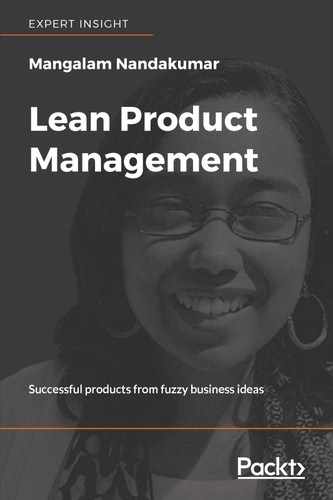In the early stages of product development, effort is creative, experimental, and iterative. The focus remains on finding the product-market fit. The product must prove that business outcomes of growth, sustainability, and influence are achievable. Product-market fit should define the recipe for what works well for the business, while offering the most value to the customers. In this phase, speed, Agility, focus, decision-making, and team empowerment are essential tenets for organizations. This helps them to stay on course without running out of resources. Product management acts as the orchestrator that enables product development. It can help to amplify impact to meet business outcomes and offer customer value. Yet, there are reasons why teams fail.
This chapter addresses the following topics:
- Tenets of lean software development
- Why team empowerment is essential for building successful products
- Two main aspects of empowered teams
"If you really want to do something, you'll find a way. If you don't, you'll find an excuse."-- Jim Rohn
Mary and Tom Poppendieck, in their book, Lean Software Development, lay out a finely compiled guide of the lean principles that can be applied to software development. They rightly caution against the misapplication of manufacturing and civil engineering practices to software development:
"Software development has tried to model its practices after manufacturing and civil engineering, with decidedly mixed results. This has been due in part to a naive understanding of the true nature of these disciplines and a failure to recognize the limits of the metaphor."
As the authors have pointed out in the book, it is this failure to recognize the limits of the metaphor that is prevalent in product teams. The mindset of thinking that software development is akin to manufacturing/production has a huge implication on how teams perceive software practices. We place an inordinately high emphasis on processes. These processes seek to optimize development, treating it as if it is a repeatable task that can follow a spec.
Mary and Tom Poppendieck compare development to designing a recipe, where iteration and variability in results are actually value-adds, as opposed to production, where variable results are bad, and iterations generate waste. The early stages of product development (preproduct-market fit) require processes, and Agility, suited to development and not production. We're trying to find the right recipe, not produce food for the masses. Not yet! Preproduct-market fit product teams have to be nimble and ready to iterate or throw everything away and start from scratch. We have to try out various experiments in order to find the most valuable product for the consumer. We need to deliver on the business outcomes before we run out of resources. However, there are many reasons why teams fail to find the right balance in how they well they collaborate. This happens even when they intend to be Agile, respond to feedback, have the best interests of the consumer at heart, and are savvy about costs. The key tenets of lean and their counter-patterns, laid out in Mary and Tom Poppendieck's book, are as follows:
- Eliminate waste does not mean throw away all documentation
- Amplify learning does not mean keep on changing your mind
- Decide as late as possible does not mean procrastinate
- Deliver as fast as possible does not mean rush and do sloppy work
- Empower the team does not mean abandon leadership
- Build integrity in does not mean big, upfront design
- See the whole does not mean ignore the details
Throughout this book, we have looked at the following:
- Eliminating wasteful processes by throwing away processes and metrics relating to team productivity
- Amplifying our learning by investing in key business outcomes and defining success metrics upfront so as to learn valuable product insights, and not just fail fast
- Decide as late as possible by thinking through build versus buy versus not at all and gathering data to make informed decisions
- Deliver as fast as possible by setting up outcome-driven timelines and identifying the smartest way to deliver impact
- Building integrity in by ensuring that impact (business outcomes and customer value) remains the key goal of all product development and setting up a data strategy to track, measure, and share product adoption insights
- Seeing the whole by defining an Impact Driven product that ensures that we build an end-to-end product experience, and not just isolated pockets of product efficiency
This book offers a framework for working through the details of the product. We started with the strategic business goals and narrowed them down to the finer details. Product backlog planning and iterating on feedback is reviewed in the context of key business outcomes. While teams can adopt this framework (as I am hopeful you will), teams that are not empowered will find it hard to apply it effectively. I want to place the focus on empowering the team from two different aspects. The first is in the context of decision making and the second is in the context of collaboration.
